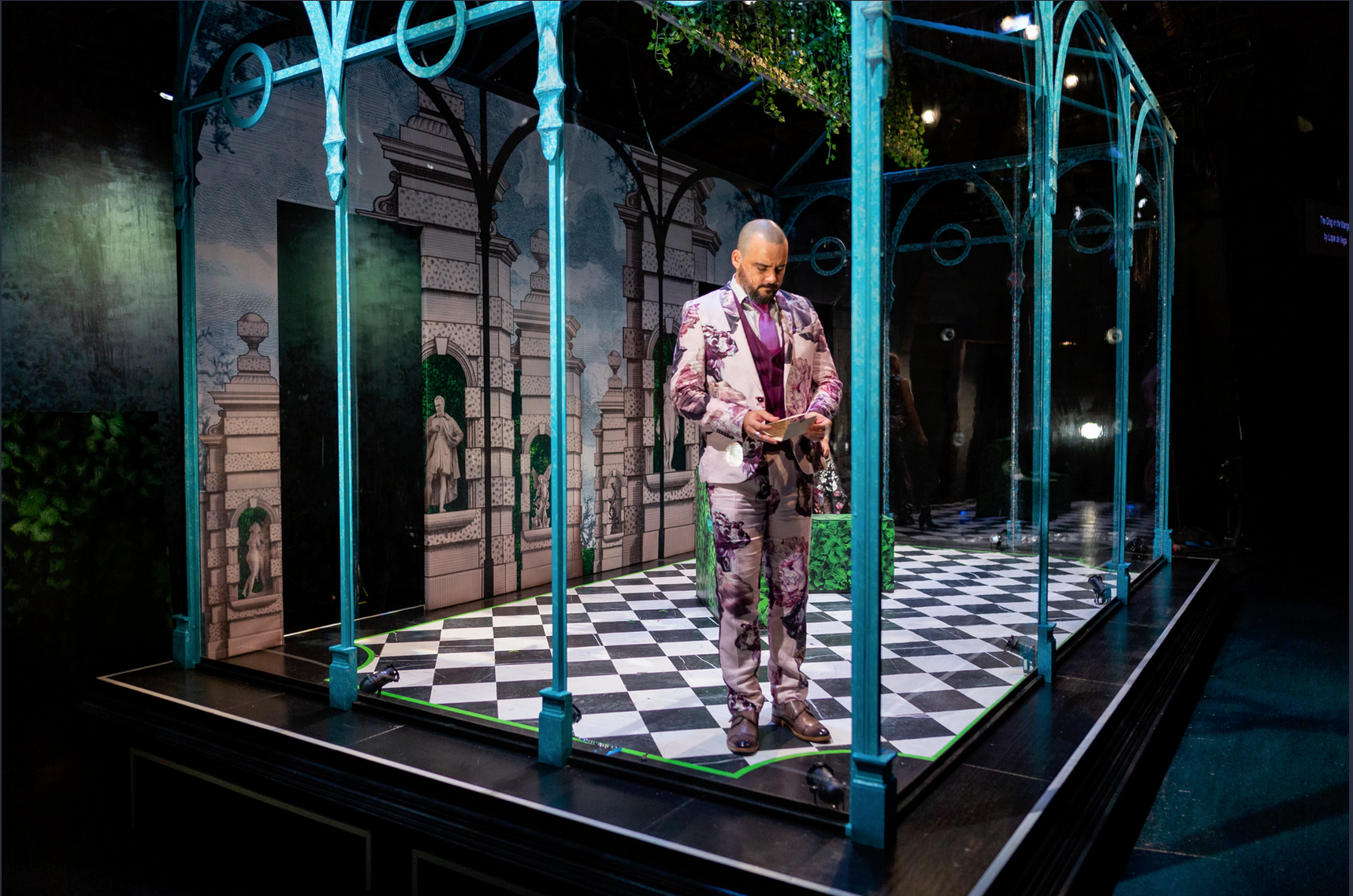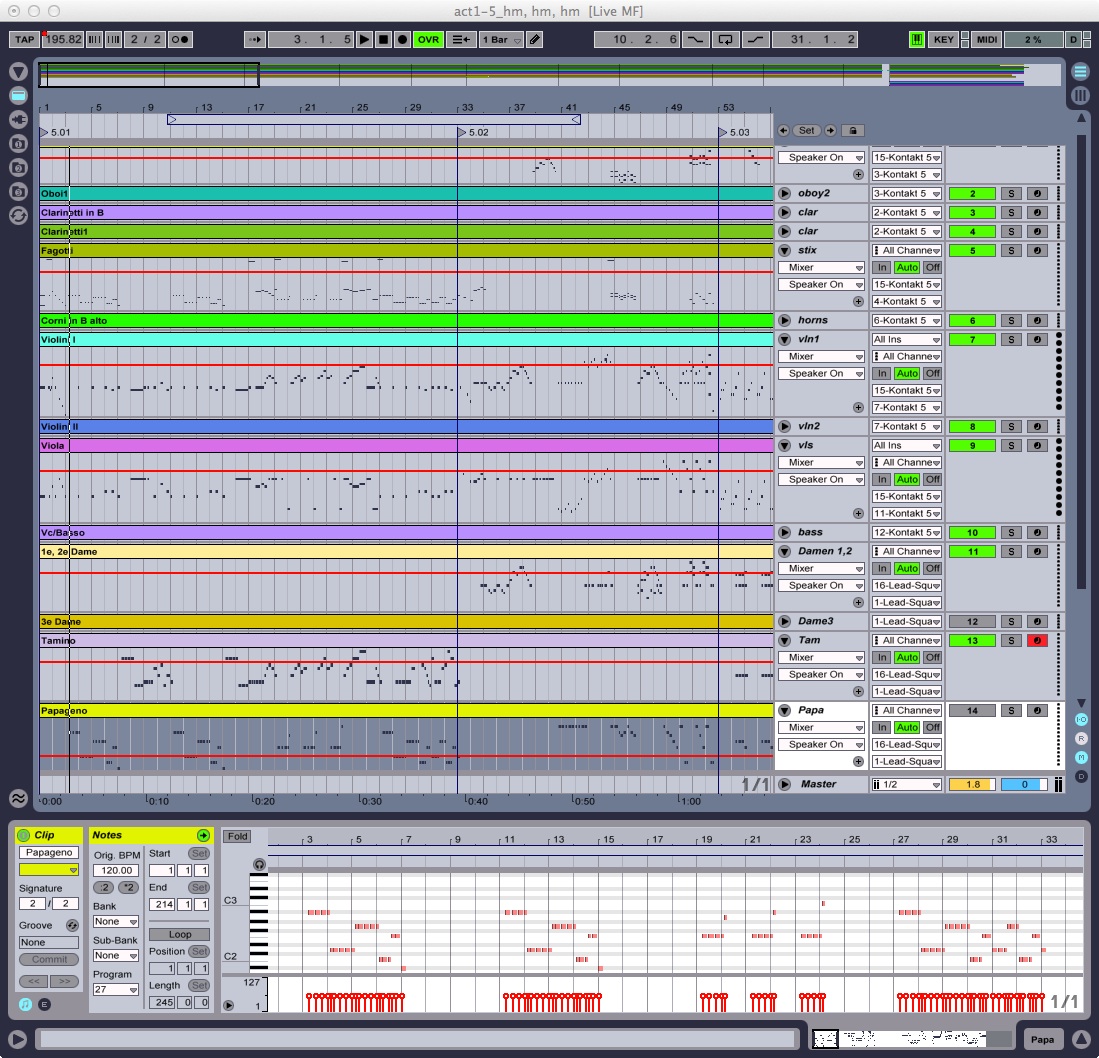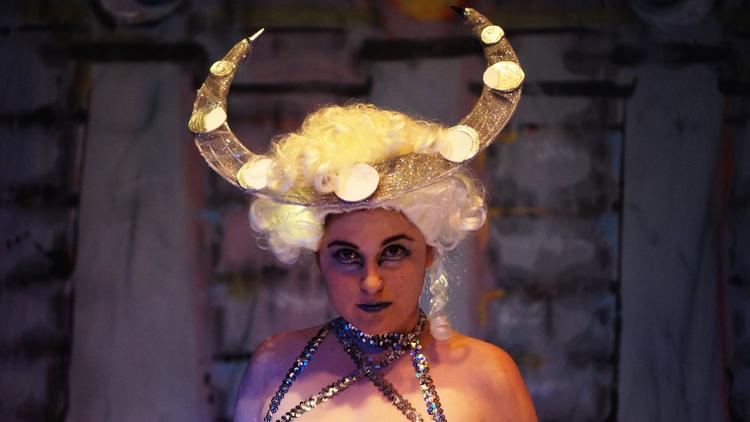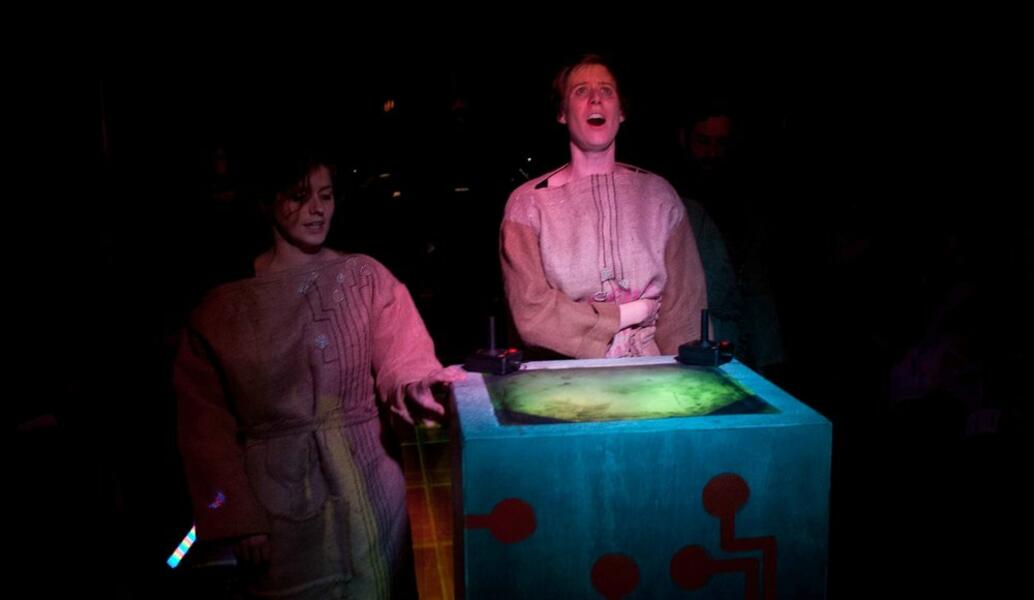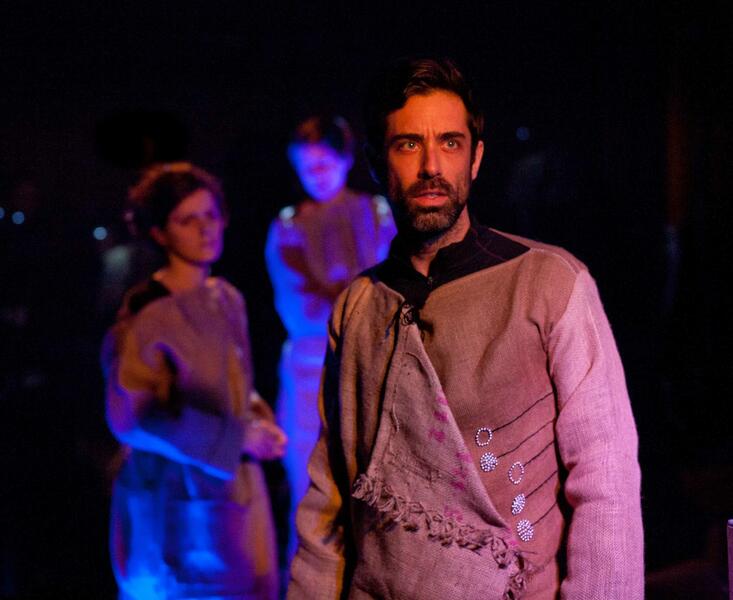Work samples
-
Baker Work Samples 2021A taste of my music, sound design, and lighting design work over the past year. I had a busy pandemic year, helping a number of venues stay alive in a challenging environment and getting the chance to try new styles and methods, and work with an array of talented playwrights and directors. 2020's graphic-novel-inflected work tilted toward animation in two of these examples, and I had opportunities to delve into video editing as well.
About David
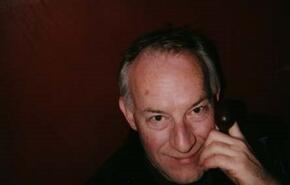
From an undergrad fascination with English ritual street theater and Peter Brooks’ THE EMPTY SPACE, through my years in Washington crewing with Peter Sellars’ American National Theater, then as one of the first sound designers on the mid-Atlantic theater scene, to my 27 years in Baltimore, I’ve been interested in theater “in the wild.” I’ve pursued theater that lives in the interstices of commercial, academic, and regional theater spaces. In this, I have leveraged an outsider point-of-view… more
Theater in a Plague Year I: Online productions with Spooky Action Theater
After a few experiments in late spring of 2020, Spooky Action Theater in Washington DC devised a way to create a more fully-realized production: record the actors on Zoom, place them into a graphic environment using graphic- and video-design tools, and hand the result off to me to design sound and music to, as well as doing the final mix. From June 2020 to September 2021, I had the opportunity to design and compose sound (and occasionally, edit the video) for a total of 19 productions, from short one-acts to full-length productions. This gave me a chance to explore an unusually broad range of different styles and approaches.
Director Craig Baldwin, in particular seized an opportunity to take the creative process one step further: connect the Zoom screen to the world of graphic novels—passing from the attempt to present a virtual stage to a more successful realization of the work on a virtual page. Please see the associated video for excerpts from ZERO by Ian August, A Dog Is a Creature of a Nose by Emma Gibson, and Water Doesn't Kill by Alaina Messineo.
Other virtual productions (for a total of 14 scripts in 2021 alone) included:
- I’ve Seen It All by Olivier Sylvestre (tr. Richard Henrich) dir. Jeremy Keith Hunter
- Ladies Room by Alex Church-Gonzales, dir. Tẹmídayọ Amay
- The Real Inspector Hound by Tom Stoppard, dir. Richard Henrich
- Chicken is Condemned To Be Free by Jesse Jae Hoon, dir. Jeremy Keith Hunter
- Cindy the Dreamer by Julia Izumi, dir. Gillian Drake
- Collect Call by Marie-Ève Milot et Marie-Claude St-Laurent (tr. Richard Henrich), dir. José Zayas
- Adam + Rose by Emma Gibson, dir. José Zayas
- Final Contact by Alex Lin, dir. Jacob Janssen
- Artichoke Country by Laura Shamas, dir. Greg Strasser
- The World Is Sand by Jacob T. Zack, dir. Elizabeth Zinkova
- Hell: An Orientation by Bridget Grace Sheafff, dir. Samantha Wyer Bello
- The Devil Exclusive by Jeff Dunne, dir. Samantha Wyer Bello
-
Spooky Action Virtual Plays 2020-early 2021Original music and sound design for online productions with Spooky Action Theater and director Craig Baldwin: 1. ZERO: desire, danger and the forbidden in the New England woods. 2. A DOG IS A CREATURE OF A NOSE: life and death, "seen" through the nose of a dog. 3. WATER DOESN'T KILL: a bereaved mother reaches out to her daughter, veering toward suicide. (We used different "room tones" to reinforce her fragmented sense of time and memory.)
Theater in a plague year II: a live production of Lope de Vega's El perro del hortelano
In Fall 2020, eight months into the COVID-19 crisis, Gala Hispanic Theater was afforded a unique opportunity: as a test for possible future shows, the District of Columbia government permitted Gala to mount the city's first fully staged production for limited-capacity audiences. The facility was revamped for COVID protections and extensive testing was carried out; the project was carefully monitored for risks, and ultimately concluded a successful run with no new infections.
The play was a classic of Spain's Golden Age of theater: Lope de Vega's romantic comedy-cum-social satire "El perro del hortelano," or "The Dog In the Manger," in a streamlined modern adaptation set in a futuristic Venetian club scene.
The set was encased in plexiglas walls as a barrier for aerosols from the performers, who were not masked. This required the use of microphones on everyone, and provided a unique sound-design opportunity. Isolated from the speakers by the plexi walls, the normally feedback-prone microphones could be mixed and effects applied much more creatively. The overheated passions of the close-miked characters could be voiced with telenovela-like reverb effects.
Pulsing club music filled the world on the stage, while speakers surrounding the audience provided an environment for this "terrarium of passions"—the jewel-like set confining the action was heard as if placed outdoors in a garden, the sounds of which provided a gentle context during quiet moments.
-
El Perro in the garden:Live sound mix, original music and sound design: an excerpt from El perro del hortelano, at Gala Hispanic Theater, October 2020. The Spanish version of our "dog in the manger" story is called "the gardener's dog" after a dog who guarded vegetables he would not eat. The set for El Perro had walls of plexiglass, and sat onstage like a terrarium set outdoors in a garden. During lulls in the action, natural sounds from the garden could be heard surrounding the audience.
-
 Teodoro reads a love letter - Daniel Martínez.pngThe hero, Teodoro (Ariel Texido) reads a love letter. Enclosing the actors behind glass required the use of microphones, but also enabled us to create many creative cinematic audio effects.
Teodoro reads a love letter - Daniel Martínez.pngThe hero, Teodoro (Ariel Texido) reads a love letter. Enclosing the actors behind glass required the use of microphones, but also enabled us to create many creative cinematic audio effects. -
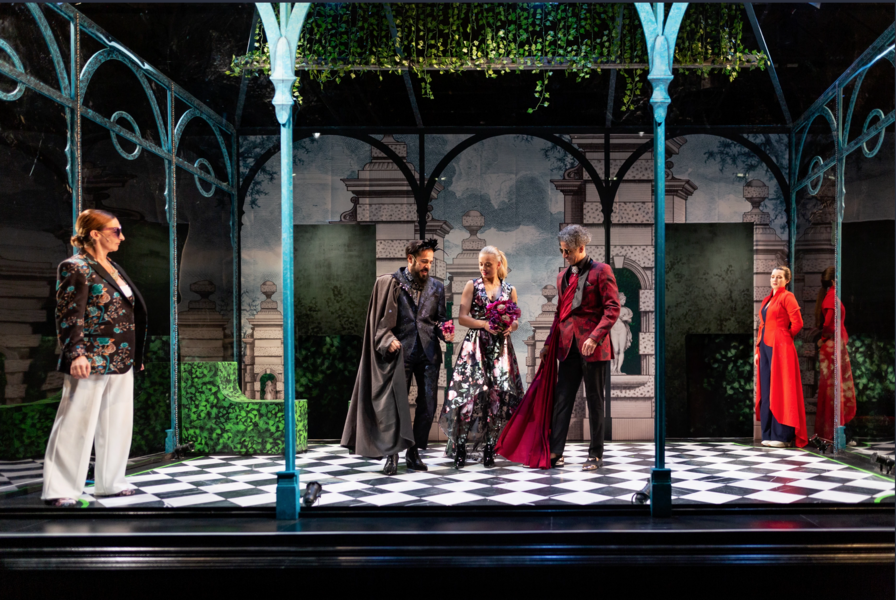 Diana and her suitorsA wide view of the set, with the cast. Director José Zayas used vivid costumes and energetic club music between and during scenes to reinforce the "emotional hothouse" effect. Photo by Daniel Martínez
Diana and her suitorsA wide view of the set, with the cast. Director José Zayas used vivid costumes and energetic club music between and during scenes to reinforce the "emotional hothouse" effect. Photo by Daniel Martínez -
 Echoing breathAt one point in the play, the heroine Diana (Soraya Padrao) breathes on the glass wall of the set and draws a heart in the surface fog. We captured the sound of her breath and sent it echoing around the theater. The actors quickly learned to use their microphone's proximity to the reflective glass surface to create aural effects of their own.
Echoing breathAt one point in the play, the heroine Diana (Soraya Padrao) breathes on the glass wall of the set and draws a heart in the surface fog. We captured the sound of her breath and sent it echoing around the theater. The actors quickly learned to use their microphone's proximity to the reflective glass surface to create aural effects of their own.
Original music 2018: En el tiempo de las Mariposas
Original music 2018: Como agua para chocolate
At one point in the show, this musical sequence was used to cover a longish pantomime depicting 15 years passing in the life of the de la Garza family. I was reminded of François Couperin's "Les Barricades Mystérieuses" while creating this music, so I guess that makes it an hommage of sorts.
-
D Crandall 2018: Como agua para chocolateFrom Laura Esquivel's beloved novel. At one point in the show, this musical sequence was used to cover a longish pantomime depicting 15 years passing in the life of the de la Garza family. (I was reminded of François Couperin's "Les Barricades Mystérieuses" while creating this music, so I guess that makes it an hommage of sorts.) Production photos by Daniel Martinez.
Some lighting designs 2016-2017
After a second act that was a comedic cabaret, the third section of the piece turned dark and mysterious as the audience, now facing the back of the stage, witnessed a performance tied together by mystery, sound and salt.
The Shattering Frame was a unique noir tale of urban corruption, produced by Annex Theater in 2017. Director Trevor Wilhelms wanted a shadowy, fluid lighting treatment, controlled by the actors during performance. Four small spotlights were hand-held by performers and controlled from the dimmer system. This low-tech "moving lights" approach permitted many unique effects to be produced, which lent the story the demimondaine aspect it deserved.
The Fête of Mistakes, produced by Psychic Readings Company at Le Mondo in December 2016, presented a number of interesting challenges and opportunities. The performance space, lacking an existing lighting system or grid, became an intimate, claustrophobic theater that opened out into the wider space of Le Mondo for a spectacular finale demolition derby. Lighting instruments, ranging from LED flashlights to clip lights to standard theatrical fixtures, were used to create a subterranean "Cave of the Winds" beneath Niagara Falls.
-
 first section of SUBJECT/OBJECTNaoko Maeshiba makes an entrance.
first section of SUBJECT/OBJECTNaoko Maeshiba makes an entrance. -
 under the front rowNaoko under the first row of audience, before the "birth" sequence.
under the front rowNaoko under the first row of audience, before the "birth" sequence. -
 IntermissionBefore the start of the third section of Subject/Object
IntermissionBefore the start of the third section of Subject/Object -
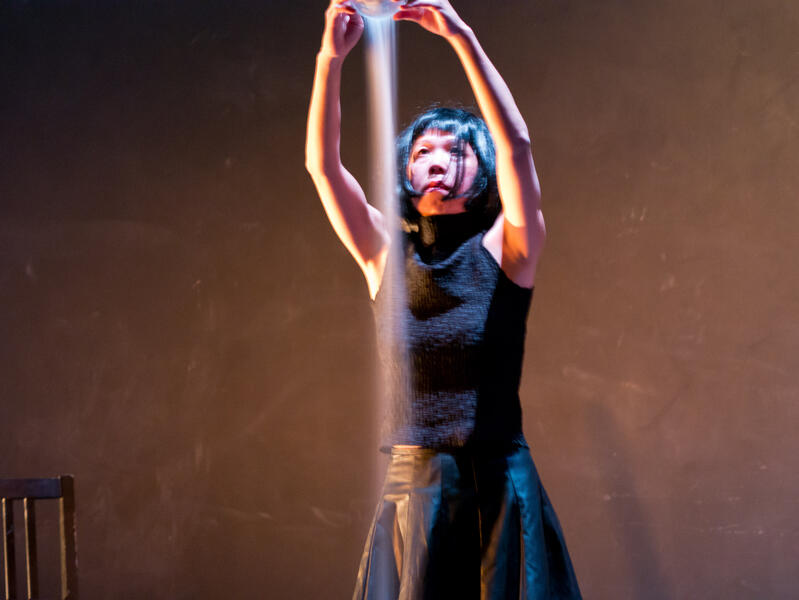 P1110359.jpgPouring salt.
P1110359.jpgPouring salt. -
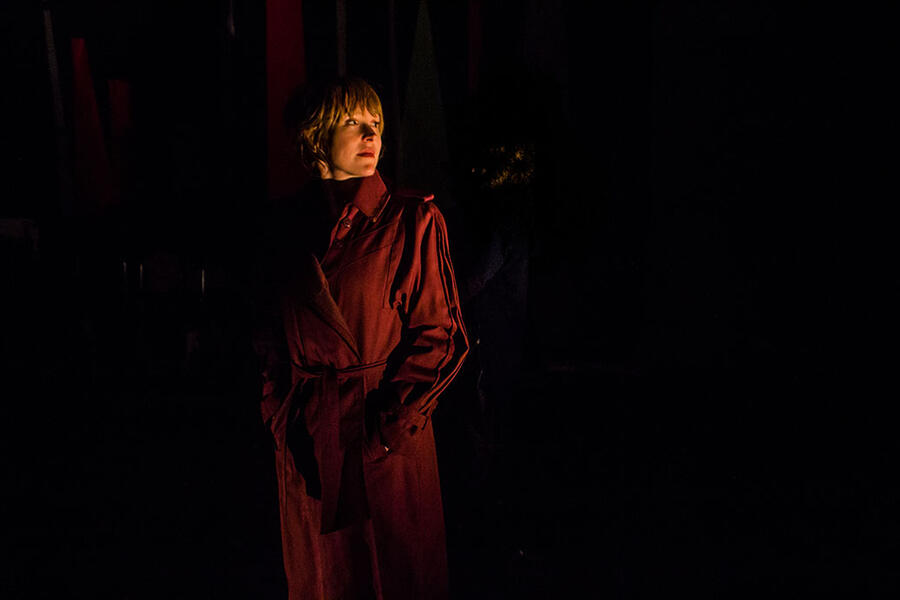 The Shattering Frame: BridgetteAutumn Breaud as Bridgette Miakaowski
The Shattering Frame: BridgetteAutumn Breaud as Bridgette Miakaowski -
 The Shattering Frame: Talk!A rat, played by Dave Iden, gets the treatment, courtesy of Mika Nakano
The Shattering Frame: Talk!A rat, played by Dave Iden, gets the treatment, courtesy of Mika Nakano -
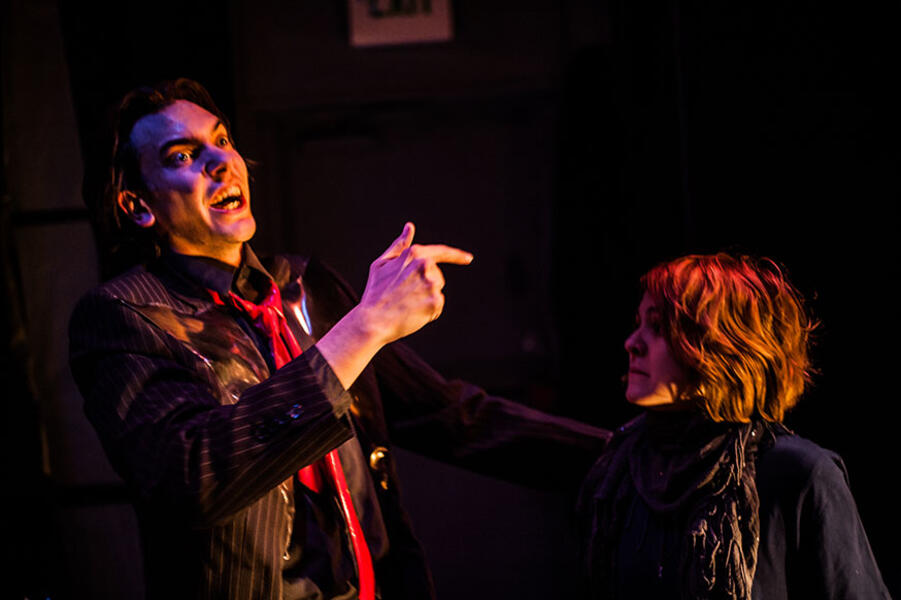 The Shattering Frame: The Mayor in TroubleThe Kid confronts The Mayor (Jacob Zabawa)
The Shattering Frame: The Mayor in TroubleThe Kid confronts The Mayor (Jacob Zabawa) -
Fête of Mistakes: The Fortune TellerMyself as David Johannes Crandall, Guesser of Obvious Fortunes
-
Fête of Mistakes: The Long Armed Lady dancesFiona Crowley as The Long Armed Lady. Photo by Dave Iden
-
Fête of Mistakes: Taking a momentRic Royer as The Actor. Photo by Dave Iden.
Original music and sound design examples, 2015-2017
- don Juan Tenorio, Gala Hispanic Theater, Washington, DC, 2017.
- The Master and Margarita, Annex Theater, Baltimore, 2016.
- The Year of the Rooster, Single Carrot Theater, Baltimore, 2015.
- Jarry Inside Out, Spooky Action Theater, Washington DC, 2015
- Richard III, Chesapeake Shakespeare Company, Baltimore, 2017.
- Minotaur, Annex Theater, 2016.
Mozart's THE MAGIC FLUTE at Annex Theater: music direction & orchestrations
Budget ruled an orchestra out of the question—the score would have to be played on computer and built in software—but it occurred to me to embrace this fact by scoring the orchestra as a collection of sampled toy, mechanical, and a few historical and folk instruments. By "historical" I mean samples of not just 18th century orchestral instruments, but also authentic 1950s and 60s synthesizers, including the unique Jennings Univox, a vacuum-tube instrument from 1954. The result was an exceptionally warm and unique accompaniment for the singers. The score was mixed in 4-channel surround and played back on computer.
Annex company member Jacob Budenz joined me as director of the singers, and we collaborated on stylistic details; Evan Moritz directed the staging, and Doug Johnson provided magnificent painted backdrops that paged like a giant picture-book to reveal the settings.
Photos by Dave Iden
-
 "Hm! Hm! Hm!"The orchestration of the quintet "Hm! Hm! Hm!" featuring (the magically silenced) Papageno, Tamino and the three Ladies, set up for editing as MIDI data in Ableton Live.
"Hm! Hm! Hm!"The orchestration of the quintet "Hm! Hm! Hm!" featuring (the magically silenced) Papageno, Tamino and the three Ladies, set up for editing as MIDI data in Ableton Live. -
PapagenoIshai Barnoy as Papageno in Annex Theater's production of THE MAGIC FLUTE
-
 Virtual orchestraA "rack" of digitally-sampled instruments in Native Instruments' KONTAKT application. Note the presence of various toy instruments. The panel at the bottom holds controls for the Jennings Univox synthesizer plugin.
Virtual orchestraA "rack" of digitally-sampled instruments in Native Instruments' KONTAKT application. Note the presence of various toy instruments. The panel at the bottom holds controls for the Jennings Univox synthesizer plugin. -
 The Queen of the NightAllison Clendaniel as Queen of the Night in Annex Theater's production of THE MAGIC FLUTE.
The Queen of the NightAllison Clendaniel as Queen of the Night in Annex Theater's production of THE MAGIC FLUTE. -
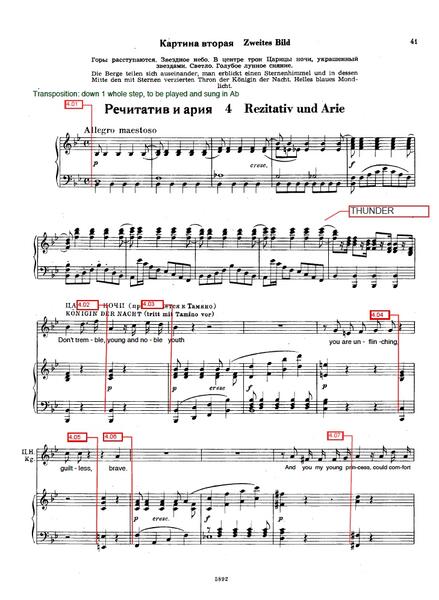 Rehearsal scoreA page from the Queen of the Night's first aria. Red markings indicate "rehearsal letters" corresponding to phrases to be manually cued in performance. We found a Russian-language piano score that had plenty of space to insert our new English translation.
Rehearsal scoreA page from the Queen of the Night's first aria. Red markings indicate "rehearsal letters" corresponding to phrases to be manually cued in performance. We found a Russian-language piano score that had plenty of space to insert our new English translation. -
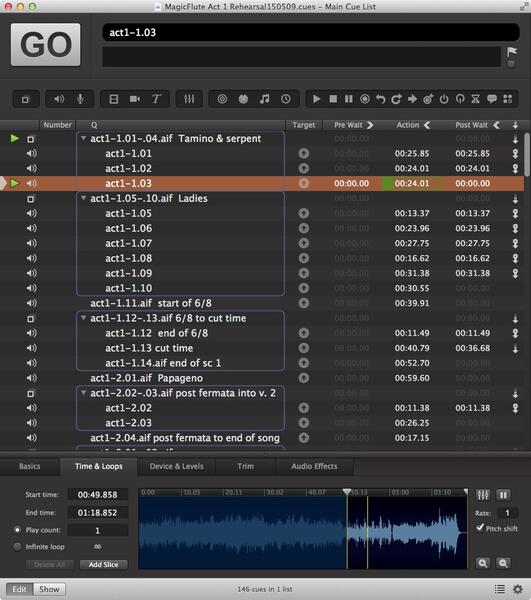 Real time playback controlThe music was broken up into phrases for easier rehearsal cuing, and larger sections to be manually cued in performance by the stage manager. This software is Qlab, from Baltimore-based company Figure 53.
Real time playback controlThe music was broken up into phrases for easier rehearsal cuing, and larger sections to be manually cued in performance by the stage manager. This software is Qlab, from Baltimore-based company Figure 53. -
Overture excerptA brief excerpt from the Overture using sampled toy and mechanical instruments.
THE WEDDING DRESS: Projections (and sound) design
The video design for this project was based on a small projector mounted in a housing that mimicked the movie cameras of the day, and allowed projected imagery to play across the curtain, permitting actors to have access from either side, and also to "shoot" video onto actors' bodies, upstage walls and other surfaces.
I also contributed the sound design for this project.
-
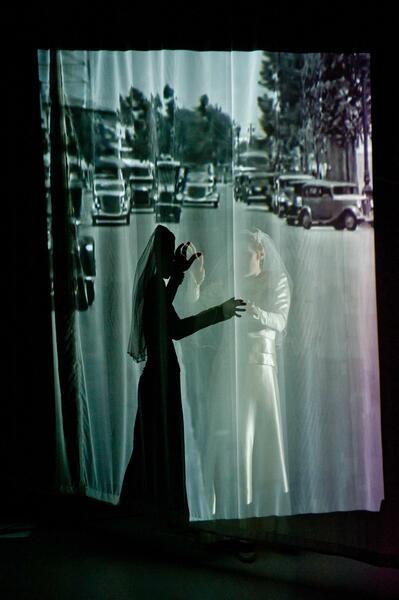 Video on the curtainVideo of Rio de Janeiro traffic projected onto a sheer curtain, with an actor behind "mirroring" her own shadow.
Video on the curtainVideo of Rio de Janeiro traffic projected onto a sheer curtain, with an actor behind "mirroring" her own shadow. -
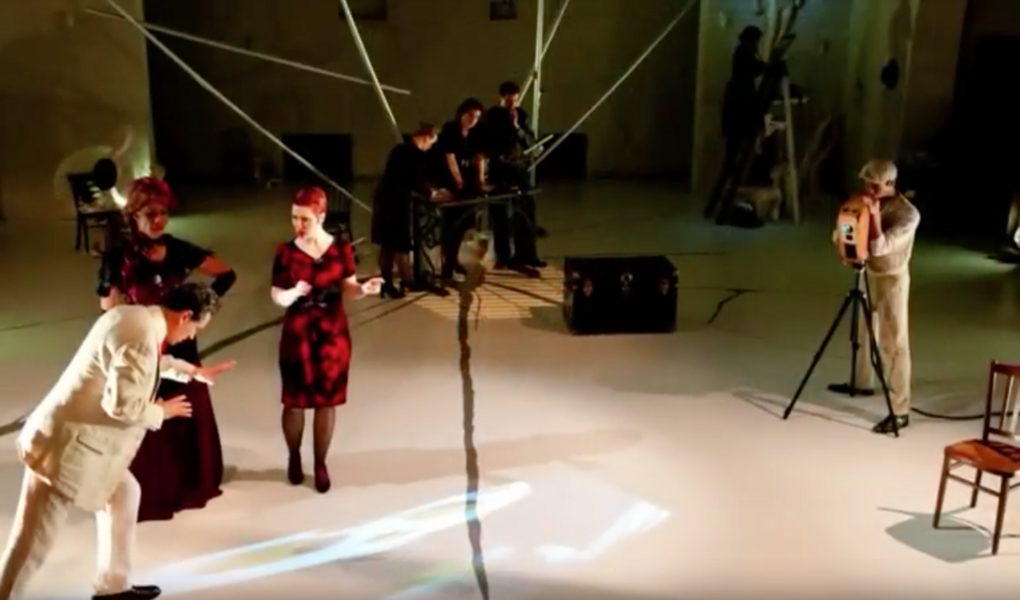 General viewThe playing space with the curtain open. Note the projector in its housing on a tripod to the right, and the image on the floor, where the actor is looking.
General viewThe playing space with the curtain open. Note the projector in its housing on a tripod to the right, and the image on the floor, where the actor is looking.
Rhymes with Opera's RED GIANT: Lighting and projections design, tech direction
Adam Matlock's Red Giant was an excellent choice for this. Set in a time when the Sun has become a "red giant" and is about to engulf the Earth, this opera follows three individuals who, among many others, have built jury-rigged spaceships and blasted off for destinations unknown, to escape certain destruction at home.
The lighting rig was very simple: a few instruments on either end of a tiny (8' wide) playing area, LED strip lights along the sides of this "rocket," and a scrim upstage that screened the orchestra (a home security monitor provided a conductor's video feed to the singers via a small CRT that was part of the set). Complex colors and imagery were provided by a single video projector mounted behind and above the action, which washed the singers with nostalgia-laden imagery as they sang of their lost home.

